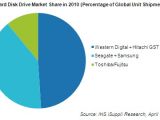Hitachi, a newly-acquired HDD division of storage giant Western Digital is presenting today the new 7mm slim HDD called CinemaStar Z5K500, on its official website. The new line of drives is obviously targeted for ultralight and ultrathin notebooks that, today, are the most marketed mobile devices by both, AMD and Intel.
The CinemaStar Z5K500 comes in three variants. There is a 250GB version, a 320 GB and a 500 GB one.
The maximum areal density of the platters is 630Gbit/square inch.
All the models come with a generous 32 MB of cache although we would have liked at least a 256 MB one. With the current HDD global duopoly in place, there is no real competition left so we shouldn’t expect too many impressive achievements anytime soon. It seems that 32 MB is enough.
The spindle speed is 7200 RPM, while the whole device communicates on a SATA 3 interface.
Western Digital/Hitachi claims that the drive is very power efficient and consumes just 1.4 watts when idle, while being very silent. The targeted markets are the new slim TVs and multi-tuner DVR systems.
Hitachi is also launching a 9.5-millimeter thick drive today. This one comes with a 1 TB capacity and rotates at an ordinary 5400 RPM.
CinemaStar C5K1000 is the name of the “fatter” brother and the areal density is just a little bit higher at 694Gbit/square inch.
Western Digital’s commitment to low performance products is obvious here, as all the models in this line not only come with a slower spindle speed of 5400 RPM, but they also feature a 75% smaller cache of just 8 MB.
The CinemaStar C5K1000 has two platters, unlike the CinemaStar Z5K500, and that’s where the extra thickness is coming from.
In its bid to completely eliminate or buy off the competition and despite complaining about the "HDD crisis", Western Digital had enough money left to acquire Toshiba’s Thailand HDD factory. This is after paying 2 billion dollars for Hitachi’s HDD division last March and after paying 700 million USD to its shareholders in dividends.
Was that money coming from the grossly high prices we pay now for HDDs that WD and Seagate had in storage before the Thailand floods? It’s common knowledge that the HDD market was plagued by overproduction and low margins and that there were huge stocks of drives before the floods came.
HDD manufacturers are forced to keep up production, as buying more HDD parts gets them lower prices from their suppliers. As the price of a 1TB HDD was close to 50 USD last year, the manufacturing costs had to be kept strictly in check.
They had to manufacture large quantities despite not having immediate sales. HDDs are a commodity that don't lose their value as fast as RAM modules do (just an example).
You can manufacture a 1 TB HDD in January one year and have absolutely no worry about it losing its value because next year, due to the fact that the HDD industry evolves at snail-speed, you would surely sell it anyway.
So why not produce more and get bigger discounts from your own suppliers?
We believe this is exactly where those "extra" HDDs came from despite having flooded fabs.
We endeavor to say that the profit/margins problem is solved now.
This will enable WD to produce more 2.5” HDDs and will most likely lead to a rise in the price of such HDDs, as Toshiba’s own output on this market is likely to diminish.
Toshiba bragged about doubling its sales, but we hardly believe this will be the case, as selling your factories is not a first step when you’re trying to increase production.
You can see from the graph above how the HDD market looked early last year. We expect Toshiba’s slice to diminish significantly.

 14 DAY TRIAL //
14 DAY TRIAL // 


